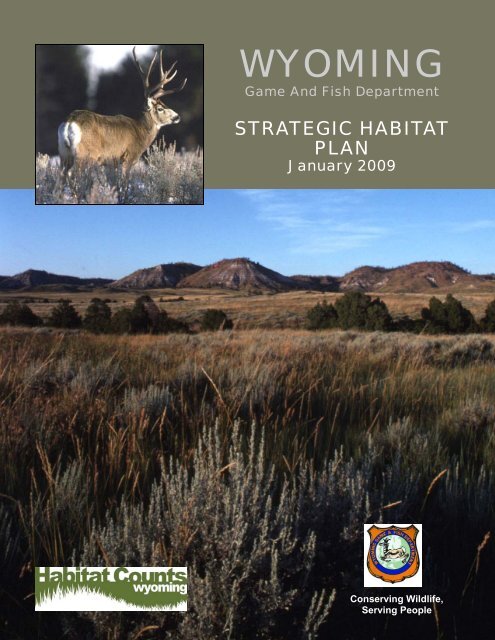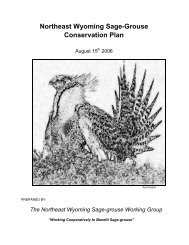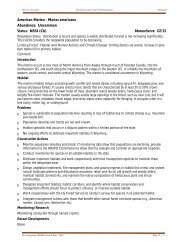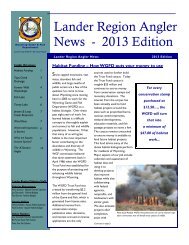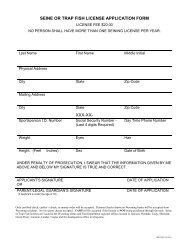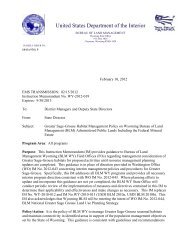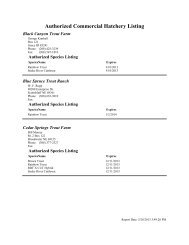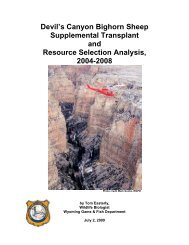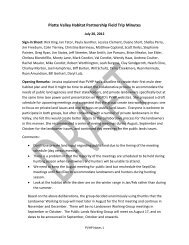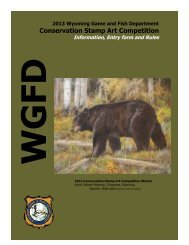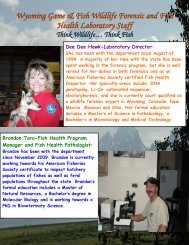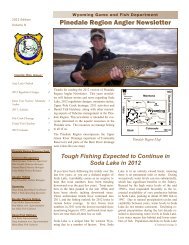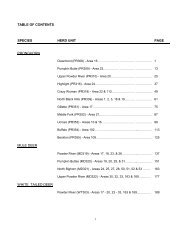Strategic Habitat Plan - Wyoming Game & Fish Department
Strategic Habitat Plan - Wyoming Game & Fish Department
Strategic Habitat Plan - Wyoming Game & Fish Department
- No tags were found...
You also want an ePaper? Increase the reach of your titles
YUMPU automatically turns print PDFs into web optimized ePapers that Google loves.
<strong>Plan</strong>ts causing problems in riparian systems include Russian olive and tamarisk. Some exoticplants, such as cheatgrass, have been present for some time but are beginning to spread at analarming rate. Invasive plants benefit from disturbances to native plant communities such asroads, well pads, pipeline corridors, tilling, and other actions that remove native vegetation anddisturb the soil. They also spread to over-grazed areas. Drought exacerbates these weedproblems by weakening native plants and plant communities giving exotics a competitiveadvantage.Over 10 years of drought combined with continued human development in the West haveheightened water demands and sharpened conflicts over its use. The drought’s impact onterrestrial and aquatic habitats are significant and pervasive and remind us of the fundamentalrole water serves in structuring <strong>Wyoming</strong>’s habitats. While the timing, rate, form and quantity ofwater delivery to <strong>Wyoming</strong>’s landscapes may change with changes in climate, habitatprescriptions and management alternatives must be adopted to ensure the water that is availablesustains natural habitat processes.In 2001, we identified several habitats or vegetation communities that were consideredimportant to maintain or enhance. These types were aspen, mixed mountain shrub, sagebrush,grassland, riparian and wetland habitats, prairie stream systems and cutthroat trout streams. Thetypes identified are still considered a high priority as 50% or more of the states aspen andriparian/wetland communities have been lost and there is a loss of quality mixed mountain shrubdue to ungulate herbivory and loss of periodic fire. Declines in water flows, water quality, lossof water flow to diversions, and loss of native fish to entrainment are significant factors inprairies stream systems and effect cutthroat trout habitat along with competition from non-nativetrout species. Within sagebrush and grasslands, habitat fragmentation, invasive weeds, alteredfire regimes and herbivory were identified as factors affecting these habitats and potentiallyimpacting sage grouse, pygmy rabbit, and a host of other sagebrush and grassland obligatespecies.In the face of these unprecedented impacts and land use changes, habitat and wildlifemanagement will clearly require an adaptive, imaginative approach to meet the WGFD missionof “Conserving Wildlife, Serving People”. Maintaining habitat values and addressing keyhabitat issues will require careful consideration, collaboration and planning followed by boldaction. The WGFD and its conservation partners must confront these challenges with limitedresources. This SHP sets forth strategies to meet these challenges.2
invasive species, lack of fish passage, loss of fish to diversions (entrainment), degraded habitat,incompatible grazing management practices and excessive stream channel instability(degradation, aggradation, lateral migration). Another important factor is the ability oropportunity for successful work in such areas. These habitat enhancement areas were selectedbecause there is realistic potential to address wildlife habitat issues in them and to improve,enhance or restore wildlife. They are areas where natural or man-caused habitat degradation isoccurring or has occurred and where the WGFD can work with partners to improve habitatcondition. The status of the wildlife species present, habitat abundance, habitat conditions,habitat connectivity, activities resulting in habitat loss, potential improvements and opportunityfor partnering were all considered when delineating these enhancement areas. The WGFD willconcentrate habitat work on these areas for the 5-year time frame of this SHP. <strong>Habitat</strong>enhancement areas may or may not overlap the crucial habitat areas. Delineation of these areaswill be valuable when prioritizing manpower and resources and when communicating withpartners interested in implementing habitat enhancement work. The relationship between Goal 1and Goal 2 areas is shown in Figure 1.Figure 1. Schematic example showing goal 1 “crucial areas” and goal 2 “enhancement areas”.The areas commonly overlap as shown or may be distinct. Maintenance conservationapproaches would be pursued throughout crucial areas recognizing that enhancementwork will also be needed (represented by the overlap region) in portions of crucial areas.Some enhancement projects will also be needed to address issues outside the crucialareas.In early 2008, WGFD regional personnel were asked to identify habitat values under Goal 1 andhabitat issues under Goal 2. Values and issues then guided identification of regional crucial andenhancement areas. Narratives describing the location, boundaries, values, issues, species, andsolutions/actions were then prepared. These narratives and associated maps were developed inconjunction with the revision of the SHP. The habitat priority areas were approved by the Chiefsof the <strong>Fish</strong> and Wildlife Divisions and are available under separate cover or by visiting the web6
site http://gf.state.wy.us/habitat. The boundaries of priority areas were delineated in severalways, including Hydrologic Unit Code (HUC) basins, overlapping crucial ranges, streamcorridors, and riparian corridors. The WGFC’s Wildlife <strong>Habitat</strong> Management Areas that werenot included within a Crucial <strong>Habitat</strong> Area were included as <strong>Habitat</strong> Enhancement Areas.Priority areas were not identified in Yellowstone National Park and the Wind River IndianReservation because the WGFD does not have wildlife management authority there. The onlyexception is the inclusion of sage grouse core areas described by Governor Dave Freudenthal’sExecutive Order 2008-2 within the Wind River Indian Reservation.<strong>Habitat</strong> Project SelectionThe WGFD has developed a Trust Fund with approximately one million dollars availableannually. <strong>Habitat</strong> funding is available from a variety of external sources, and the WGFD isconsulted regularly regarding partnering with other entities on habitat projects and asked foradvice on prioritizing habitat work other entities are considering. To wisely allocate these fundsto projects that will result in significant and long-term habitat conservation and management, aproject ranking system will be employed. A systematic project ranking approach ensures thatproject proponents are aware of how proposals will be evaluated and helps provide consistencyand objectivity in the selection process. The approach below (Table 1) will be used to assignranks to proposed habitat projects (e.g., WGFD Trust Fund, Wildlife and Natural Resource TrustAccount and other habitat funding sources as appropriate).Project development, submittal and evaluation will proceed as in the past where each ofthe WGFD’s regions, through the Regional Coordination Teams, will annually provide ranked orprioritized project proposals. Aquatic and Terrestrial <strong>Habitat</strong> Section Managers will lead theHTG in reviewing all regional and statewide project proposals and supplement regional rankingswith the prioritization scheme to provide a statewide prioritization and funding recommendationsto the HPG. To the extent possible, all proposals will be reviewed at the same time each year.As described in the Background and <strong>Plan</strong>ning Process section above, Crucial <strong>Habitat</strong>Areas (Goal 1) were selected based on habitat values, and <strong>Habitat</strong> Enhancement Areas (Goal 2)were selected based on habitat issues within those areas. A narrative was written for each of thepriority habitat areas (see the companion document to this plan or the WGFD web sitehttp://gf.state.wy.us/habitat for narratives and associated maps). Projects proposed within theseareas will be evaluated based on whether they address the values or issues described in thenarratives. Projects that are proposed outside the Crucial <strong>Habitat</strong> Areas and <strong>Habitat</strong>Enhancement Areas (collectively called priority habitat areas) will be considered based on theirmerits as described in the project proposal with emphasis on whether or not they contain theimportant habitats identified earlier (i.e., aspen, mixed mountain shrub, sagebrush, grassland,riparian and wetland habitats, prairie stream systems and cutthroat trout streams).7
<strong>Strategic</strong> <strong>Habitat</strong> <strong>Plan</strong> and Other WGFD <strong>Plan</strong>sAn important role of this revised SHP is clarifying how this planning effort relates to thearray of other WGFD plans, efforts and reports. To serve this role, several other plans areexplicitly identified in italics under the various strategies listed in the Goals and Objectivessection. The intent is to integrate WGFD efforts under various plans to a reasonable level,ensure plans are mutually supportive while maintaining the original intent of each plan.Following is further explanation of plan relationships.DIRECTOR’S OFFICEComprehensive Wildlife Conservation Strategy - The Comprehensive Wildlife ConservationStrategy (CWCS) for <strong>Wyoming</strong> is an action plan developed by WGFD in cooperation with anumber of conservation partners and other interested parties, including agencies, academia,conservation organizations and the general public. It is a plan intended to direct the state’s effortto conserve SGCN and to allow the state to maintain eligibility for U.S. <strong>Fish</strong> and WildlifeService administered State Wildlife Grant funding. In addition to identifying SGCN, the CWCSalso identifies important habitats for those species; and most of those habitats are included ascrucial and enhancement priority habitat areas in the SHP. The priority areas identified in thisrevision to the SHP were based on the needs of all wildlife. The narratives associated with eachpriority area include a list of the primary and secondary species impacted by the habitatconditions in that priority area. In some cases this will meet the conservation needs of one ormore SGCN while in other cases some important habitats for SGCN may not be incorporatedinto a priority habitat area. The CWCS assesses the needs of species assemblages and individualspecies and account for those that are not covered by a priority habitat area.<strong>Habitat</strong> Protection Program - This program coordinates WGFD input into planning andimplementation of energy development, federal land use plans (Forest <strong>Plan</strong>s and BLM ResourceManagement <strong>Plan</strong>s), and individual local habitat and land management projects throughout thestate. These plans and projects, in total, determine to a large extent the amount, type, andintensity of land use changes that occur in <strong>Wyoming</strong>. The SHP serves as a basis for WGFDrecommendations and negotiations to achieve the most benefit, through identification of the mostcrucial habitats, the areas where habitat enhancements would be most useful, and as centralguidance for other associated WGFD and interagency habitat programs and efforts.<strong>Wyoming</strong> Landscape Conservation Initiative - The WLCI is an interagency workinggroup of partners collaborating on a long-term, science-based effort to enhance wildlife habitatsat a landscape scale in southwest <strong>Wyoming</strong>, while facilitating responsible development. Therole of the SHP in this process is identification of key habitat values and areas for enhancement,and as support for the WLCI collaboration process, for the purpose of maintaining andimproving the most beneficial habitat values and function in areas of southwest <strong>Wyoming</strong> thatare not being impacted by energy development.Jonah Interagency Office - The JIO is an entity that was established to deal specificallywith monitoring and mitigation activities for the Jonah gas field in Sublette County. The JonahRecord of Decision requires mitigation of the gas field disturbance on a 3:1 acreage basis (3acres of mitigation or equivalent function per acre of disturbance), which in turn requires a huge9
acreage of off-site mitigation to occur. The role of the SHP in this process is basic guidance forlocating and advising that mitigation, to achieve the best benefit for impacted wildlife.Mitigation Policy - The mitigation policy was established by the WGFC in recognitionthat growth, development, and land use changes will continue to occur in <strong>Wyoming</strong>, and whenadverse impacts to wildlife or their habitat is unavoidable, it directs the WGFD to develop andpromote further mitigation that best protects wildlife. It also outlines mitigation approaches andprovides mitigation categories for species and/or their habitats, including species of greatestconservation need (SGCN) identified in the CWCS for <strong>Wyoming</strong>.FISH DIVISION<strong>Fish</strong> Division produces an annual work plan, an annual progress report and basinmanagement plans. These are linked by a common set of basin or water-specific goals andobjectives. Annual work plans include both aquatic habitat and population efforts. The annualprogress report describes activities for the year and progress towards meeting these objectivesand is necessary to meet federal aid reporting requirements. The SHP is at the base of thisscheme by defining the habitat goals, objectives, strategies and priority areas that may beincorporated into annual work plans or basin management plans. The SHP provides the overalldirection for aquatic habitat efforts, and this direction should be reflected in the three otherdocuments. Aquatic habitat biologists annually report highlights of major accomplishments in a<strong>Strategic</strong> <strong>Habitat</strong> <strong>Plan</strong> Report. The basin management plans provide a general description ofhabitat conditions and issues in basins where they have been completed – further details onissues and values are provided in the SHP Priority Area Narratives for parts of some basins.Additional <strong>Fish</strong> Division plans relate to the SHP. Water Management has a 5-Year plandescribing goals and objectives for pursuing instream flow water rights and other watermanagement activities. This plan is due for revision in 2010. Efforts described in that plan arelargely consistent with the priorities and efforts developed in this revised SHP and consistencycan be further increased during future revisions. Also, a fish passage program proposal iscurrently being developed and contains further detailed goals and objectives that fall under themore broadly stated goals of this SHP. There are also numerous fish species conservation plansand agreements that contain habitat maintenance or improvement provisions. Examples includeConservation agreements for Colorado River Cutthroat and Bonneville Cutthroat trout.Administrative reports are produced periodically and provide detailed aquatic wildlife andhabitat assessments. Often, habitat recommendations developed in these reports provide thebasis for future efforts. A myriad of other <strong>Fish</strong> Division plans and collaborative efforts includesignificant habitat components. Examples include the National <strong>Fish</strong> <strong>Habitat</strong> Action <strong>Plan</strong> and theWestern Native Trout Initiative.WILDLIFE DIVISIONWildlife biologist and game warden management recommendations rely on habitatproduction and utilization surveys, as well as other population and habitat studies anddescriptions of habitat treatments. In addition to the various forms of data collection for biggame and game birds, surveys are conducted for migratory game birds, nongame birds andnongame mammals. These species categories have management objectives, and in some cases,10
especially for waterfowl, there is habitat monitoring (e.g., pond counts and vegetationassessments).The Terrestrial <strong>Habitat</strong> Section develops personnel goals to meet habitat goals and, likethe Aquatic <strong>Habitat</strong> Section, produces an annual work schedule to address the issues prioritizedin the SHP. Progress toward meeting these annual goals and priorities is reported in an annualSHP Report.The following are some of the primary terrestrial wildlife planning documents that aredirectly/immediately related to the <strong>Strategic</strong> <strong>Habitat</strong> <strong>Plan</strong>:• Big and trophy game management objectives in annual Job Completion Reports• South Wind River Mule Deer Herd <strong>Habitat</strong> Management <strong>Plan</strong>• <strong>Wyoming</strong> Greater Sage-grouse Conservation <strong>Plan</strong>• Eight <strong>Wyoming</strong> regional (local working group) Greater Sage-grouse conservation plans• <strong>Wyoming</strong> Bird Conservation <strong>Plan</strong>• A <strong>Plan</strong> for Bird and Mammal Species of Greatest Conservation Need in Eastern<strong>Wyoming</strong> Grasslands• <strong>Wyoming</strong> Green River Basin Trumpeter Swan <strong>Habitat</strong>• Nongame Bird and Mammal <strong>Plan</strong>There is a large number of other plans (> 40), specific to individual species or groups ofspecies, at the state, region, national, and international levels, that are in some way relevant tothe SHP. Examples include: A Conservation <strong>Plan</strong> for Bats in <strong>Wyoming</strong>, ConservationAssessment and Conservation Strategy for the Swift Fox in the United States, Partners In FlightNorth American Landbird Conservation <strong>Plan</strong>, and The Northern Great Plains Joint VentureImplementation <strong>Plan</strong>. Other planning and implementation efforts tied to the SHP missioninclude the Landowner Incentive Program, the <strong>Habitat</strong> Extension Service Program and the<strong>Wyoming</strong> Mule Deer Initiative.On August 1, 2008, <strong>Wyoming</strong> Governor Dave Freudenthal issued Executive Order 2008-2 that, among other things, acknowledges and adopts the "Core Area Population Strategy"developed by his Sage Grouse Implementation Team. The Core Area Population Strategyspecifies a sage grouse core area management concept incorporating a set of stipulations andprocesses that are biologically and legally supportable. Executive Order 2008-2 directs stateagencies to focus on maintenance and enhancement of habitats within Core Population Areas.These core population areas are included in the crucial and enhancement areas for this SHP.SERVICES DIVISIONServices Division coordinates management of WGFC owned and administered landsaccording to WGFC regulations (Chapter 23), WGFC policy, <strong>Fish</strong> and Wildlife Service FederalAid regulations and guidelines per Managed Land and Access Summaries (MLAS). The MLASinclude the specific goals, objectives and strategies for each WHMA. In addition to the MLAS,there are five-year development and management plans for invasive plants, wetlands andirrigated meadows. The strategies of the MLAS and management plans are incorporated intoannual work plans as actions. Included within the annual work plans are the past years11
Action a) Maintain, use and improve, an objective system for evaluating propertyright options (e.g., <strong>Habitat</strong> and Access Evaluation Process or HAEP) to ensure theconservation of the highest value properties.Action b) Use GIS technology and the priority overlapping habitat scoring systemdeveloped by <strong>Wyoming</strong> GIS Center (WyGISC) and WGFD to help WGFD fieldpersonnel evaluate and score potential properties.Action c) Share priorities, and collaborate with land trusts, conservation groups,landowners, land management agencies and other partners to identify conservationopportunities.Action d) Enlarge and diversify funding sources by maintaining an updated list oftraditional and non-traditional funding sources.Action e) Enlarge and diversify funding sources by pursuing and using nontraditionalfunding sources to augment traditional funding sources.Action f) Develop an adequate WGFD cost-share funding base to acquire propertyrights and management agreementsAction g) Improve WGFD field personnel knowledge of the responsibilities,processes, and protocols for entering into conservation easements and landstewardship agreements to increase landowner and land management agenciesawareness about conservation options and enhance Land Protection staff outreachcapabilities.Action h) Monitor and manage easements and agreements.Strategy II) Provide professional habitat input into land management permitting,planning and review processes (e.g., Resource Management <strong>Plan</strong>s, Forest <strong>Plan</strong>s,Environmental Impact Statements, Allotment Management <strong>Plan</strong>s, WildlifeEnvironmental Reviews).Action a) Provide updated wildlife and wildlife habitat GIS data to the Governor’sOffice, State and Federal land management agencies, and other partners to fosterbetter management decisions and develop template plans that take into considerationthe major wildlife and wildlife habitat issues that need to be addressed in planningdocuments.Action b) Assign WGFD leads for land management and water planning, permittingand review processes and provide sufficient time for them to participate meaningfullyin land management planning and review processes.Action c) Continue to update, maintain, expand, and streamline the Decision SupportSystem to facilitate project review, project planning and commenting. Providefunding for WyGISC to do the work.Strategy III) Protect important fishery resources with instream flow water rights.Action a) Use the WGFD five-year Water Management <strong>Plan</strong> and annual work plansto focus and promote in-stream flow priorities.13
Action b) Work with partners and legislators to find and implement watermanagement solutions like short or long-term leases or voluntary conversions ofwater rights to instream flows.Strategy IV) Protect and maintain big game migration routes and other important wildlifemovement corridors.Action a) Maintain the wildlife migration corridor and barrier GIS layer anddistribute to all partners.Action b) Identify important wildlife movement corridors that are threatened.Action c) Develop strategies and funding sources and prioritize and implementeasements or management actions to maintain important wildlife movements.Action d) Remain involved in and support the Western Governor’s Association(WGA) Wildlife Corridors Initiative, developed to implement WGA PolicyResolution 07-01 (Protecting Wildlife Migration Corridors and Crucial Wildlife<strong>Habitat</strong> in the West).Strategy V) Attempt to minimize impacts of energy and other human impacts on aquaticand wildlife habitats.Action a) Provide input and actively participate in land management and projectplanning, process review, environmental commenting efforts and decision records asdirected by the WGFC Mitigation Policy.Action b) Work with the State Cooperator’s Group and the Governor’s Office toactively integrate sustainable aquatic and wildlife habitat components into landmanagement planning documents.Action c) Continuously update and use the WGFD’s Decision Support System tofacilitate project review and commenting.Action d) Maintain up-to-date standardized comments and recommendations (e.g.,fencing specifications, mitigation requirements for oil and gas development, pipelinestream crossing recommendations); provide them to land management agencies, otherdecision makers and project proponents; and use them in WGFD reviews of projects,where applicable.Strategy VI) Assess progress toward achieving Goal 1 and adapt managementaccordingly.Action a) Review crucial habitat values and crucial habitat areas in each region every5 years, and revise as necessary to focus habitat conservation and restoration efforts.Action b) Review progress on implementing strategies and actions identified in thisplan.Goal 2. Enhance, improve and manage priority wildlife habitats that have been degraded.Objective A) Inventory and assess wildlife habitat using an integrated watershed orlandscape approach to identify issues, limiting factors and habitat management needs andopportunities.14
Strategy I) Assess habitat identified within this plan as needing enhancement orconservation at basin and landscape scales using remote sensing and GIS technology.Action a) Collaborate with other agencies, organizations, the private sector,universities, etc. to facilitate sharing of data and costs for remote sensing.Action b) Implement the WGFD 5-year GIS plan to provide the tools and resourcesneeded by agency personnel.Strategy II) Inventory and evaluate wildlife habitat using standardized inventorytechniques (e.g., <strong>Wyoming</strong> <strong>Habitat</strong> Assessment Methodology, Ecological Site Inventory,Cooperative Sage-Grouse <strong>Habitat</strong> Assessments, WGFD Moose and Mule Deer <strong>Habitat</strong>Assessment Techniques, etc.).Action a) Use the enhancement areas and crucial areas that have remote sensingapplications to help focus annual inventories.Action b) Secure funding to conduct inventories, habitat assessments and preparemanagement recommendations thereon.Action c) Use habitat biologists, contractors and other resources to inventory, assessand prepare management recommendations within targeted areas.Action d) Collect reference reach information from <strong>Wyoming</strong> stream types fordetermining departure from stable stream form and for designing stream channelrestorations.Action e) Collect long-term data sets on WGFC owned lands where practical (e.g.,flow, water temperature, vegetation trends).Objective B) Implement projects to address and reduce habitat issues and enhance wildlifehabitat.Strategy I) Maintain agency commitment and processes to capitalize on availablefunding sources within the capabilities of our existing personnel to effectively manageprojects.Action a) Use the habitat ranking process to rank and fund project proposals thataddress WGFD priorities.Strategy II) Develop coalitions, partnerships, and other relationships to acquire fundingand support for projects.Action a) Continue liaisons and coordination with conservation organizations and the<strong>Wyoming</strong> Natural Resource Trust, and foster new relationships with groups thatpromote wildlife habitat enhancements and sustainable natural resource management.Action b) Continue and expand the habitat extension program as opportunities ariseto strengthen partnerships with the agricultural community and federal agencies andto make the best use of funding sources such as the Farm Bill.Strategy III) Emphasize implementation of watershed/landscape scale habitat projects.Action a) Use watershed/landscape level habitat inventories that provide theinformation needed to support larger scale habitat enhancements.15
Action b) Emphasize landscape scale habitat enhancements when developing workschedules and prioritizing projects.Action c) Work with WLCI and JIO among others to identify and capitalize uponopportunities to work at a landscape scale within the WLCI and JIO geographicalboundaries.Strategy IV) Maintain or enhance populations of big game, neo-tropical birds, fish andother wildlife by increasing natural movement opportunities.Action a) Prioritize big game migration corridors regionally and statewide, developan action plan, make that action plan compatible with the WGA Wildlife CorridorsInitiative, and identify and secure funding to prevent, remove or modify migrationbarriers.Action b) Use proven programs such as Farm Bill CCRP, EQUIP, WHIP, and CRPamong others for sustainable grazing management to enhance riparian corridors thatprovide habitat connectivity.Action c) Use easements and land use agreements that maintain or improve habitatconnectivity and prevent fragmentation.Action d) Maintain or enhance populations of fish and other aquatic organisms byincreasing movement opportunities and reducing loss to irrigation diversions (seeWGFD <strong>Fish</strong> Passage <strong>Plan</strong>).Strategy V) Promote sound riparian habitat with functioning riparian communities.Action a) Work with land managers and landowners to transplant and restore beaverto historical and suitable unoccupied habitat.Action b) Work with land managers and landowners to resolve sediment and otherwater quality issues related to riparian management.Action c) Work with land managers and landowners to resolve ungulate over-useissues.Action d) Work with land managers and others to promote wise human developmentof riparian areas including roads, structures, agriculture and other activities.Strategy VI) Promote functioning stream channels that maintain natural processes andaquatic habitat.Action a) Work with land managers and private land owners to enhance or restorestream channels.Action b) Work with city government, conservation groups and others to enhance orrestore stream channels and habitat within and around <strong>Wyoming</strong> Communities.Strategy VII) Educate private landowners about habitat and wildlife issues associatedwith pond development.Action a) Work with landowners, land managers and conservation organizations tolocate and design ponds that reduce the cumulative landscape and ecosystem impactsof illegally introduced species, aquatic nuisance species and thermal and nutrientissues..16
Action b) Inform landowners, land managers, and conservation organizations aboutrelationships between pond development introduced species and water qualityimpacts.Action c) Provide information to pond developers to incorporate natural andsustainable designs that benefit the broad community of native species.Strategy VIII) Mimic natural disturbance regimes using fire to provide an ecologicalbalance and vegetative landscape mosaic to enhance fire dependent vegetation andwildlife such as aspen and bighorn sheep. Where the use of fire is inappropriate orimpractical use mechanical, biological and chemical disturbances or treatments to mimicperiodic natural disturbance to enhance early succession vegetation communitiesAction a) Coordinate and plan with federal and state agencies to promote natural fire(“let burn”) management that promotes and enhances natural processes and habitat.Action b) Use prescribed fire, mechanical, biological or chemical as tools to enhancewildlife habitat and natural processes.Action c) Continue to inform and educate land managers, landowners and the publicabout the benefits of fire for managing certain vegetation communities.Strategy IX) Work with landowners, land managers and conservation organizations ongrazing management programs that enhance sustainability of rangelands and wildlifehabitat.Action a) Develop and use partnership funding sources and long-term agreementsthat provide infrastructure and incentives to facilitate grazing management thatsustains wildlife habitat.Action b) Continue to pursue and develop forage reserves and grassbankopportunities that provide needed rest and rotation for livestock grazing strategies.Action c) Use livestock grazing expertise and science to provide workshops andtechnical support that promotes sustainability of rangelands and wildlife habitat.Strategy X) Promote habitat management that enhances cottonwood and willowgalleries, aspen stands, woody draw complexes and healthy shrub communities thatbenefit wildlife.Action a) Use proven habitat manipulation techniques to manage invasive plantssuch as salt cedar and Russian olive and to restore native cottonwood and willowcomplexes.Action b) Develop and promote programs that protect, preserve and enhance woodydraw complexes to support species such as chokecherry, plum, serviceberry,hawthorn, etc.Action c) Work with landowners, land managers, partners and the public to managewildlife and livestock numbers that maintain vigorous, healthy and sustainable shrubcommunities.Action d) Inventory aspen stands/communities, determine their management needsand prioritize those that would benefit from treatment.17
Strategy XI) Promote wildlife habitat and livestock management that emphasizes nativeperennial plants and plant community diversity and sustainability to reduce the threat,proliferation and colonization of invasive non-native plant species.Action a) Actively seek partnerships and relationships to maintain WGFD awarenessof the incidence and status of invasive species and options for their control.Action b) Manage wildlife populations commensurate with the sustainability of thehabitat.Action c) Work with landowners, land managers and partners to manage livestocknumbers on the basis of, frequency, intensity and opportunity for plant re-growth andrecovery commensurate with the sustainability of habitat.Action d) In areas where cheatgrass or other non-natives exist, use managementactions and tools to correct the imbalance and maintain conditions less conducive tothese undesirable species.Action e) Use proven techniques, land stewardship practices, research andpartnerships to reduce the proliferation of invasive plant species.Strategy XII) Mitigate impacts of energy and other human impacts on habitat.Action a) Research, develop and implement successful active/post developmentreclamation techniques.Action b) Stress the need and requirement for mitigation as specified under theappropriate state and federal laws in environmental commenting.Action c) Advocate and incorporate mitigation of impacts during participation inland management and project planning, process review and environmentalcommenting.Action d) Work with the <strong>Wyoming</strong> Landscape Conservation Initiative, JIO andothers to identify and capitalize upon opportunities to conserve landscapes and openspace in SW <strong>Wyoming</strong>Action e) Evaluate required monitoring data of mitigation efforts to improve uponmitigation standards and stipulations.Objective C) Monitor effectiveness of habitat projects in reducing habitat issues andenhancing wildlife habitat.Strategy I) Collaborate with land managers, landowners and other partners to monitorthe effectiveness of habitat enhancements.Action a) Use repeatable before and after photos to record and illustrate effectivenessof habitat enhancements over time.Action b) Use WGFD and other agency permanent reference sites and monitoringstations located within or near habitat enhancements for comparison and monitoring.Action c) When monitoring is not practical, use proven habitat enhancementtechniques that provide consistent and reliable results and that have a demonstratedrecord of enhancing wildlife habitat.18
Strategy II) Assess progress toward achieving Goal 2, and adapt managementaccordingly.Action a) Review habitat issues and enhancement priority areas every 5 years, andrevise to focus habitat conservation and restoration efforts accordingly.Action b) Review progress on implementing strategies and actions identified in thisplan.Goal 3. Increase wildlife-based recreation through habitat enhancements that maintain orincrease productivity of wildlife.Objective A) Implement wildlife habitat enhancements directed at specialized needsStrategy I) Focus habitat enhancements on smaller scale areas to target specific speciesor assemblages of wildlife or to target life stages or seasonal needs of wildlife.Action a) Implement habitat enhancements that increase wildlife-based recreation asappropriate and that are complementary to other goals and objectives.Action b) Work with landowners and public and state land management agencies toimplement habitat enhancements that demonstrate the effectiveness of partnershipsand wildlife stewardship.Objective B) Monitor effectiveness of enhancements.Strategy I)Establish measurable recreation-based goals for each projectAction a) Assess whether projects have met the goals.Goal 4. Increase public awareness of wildlife habitat issues and the critical connectionbetween healthy habitat and abundant wildlife populations.Objective A) Raise awareness among key audiences about the value of healthy wildlifehabitats for <strong>Wyoming</strong>'s wildlife and people.Strategy I) In coordination with the <strong>Habitat</strong> and Technical Advisory Committee,develop an annual comprehensive outreach plan promoting the value of healthy habitat in<strong>Wyoming</strong>, using a variety of outreach tools, including internal and external publications.Outreach plan should identify key messages and could include, but will not be limited to,actions listed below.Action a) Pursue human dimensions information regarding the public's perceptionand knowledge of habitat conditions in <strong>Wyoming</strong> and how habitat relates to wildlifepopulation and hunting opportunity.Action b) Provide an annual report to constituents highlighting the major habitataccomplishments initiated or completed by WGFD. Provide report to media and poston WGFD Web site.Action c) Promote at least three habitat improvement projects in each region throughinternal and external publications, including news releases and e-newsletter.Action d) Continue "Feeding the Wild" and "On the Ground" column in <strong>Wyoming</strong>Wildlife magazine.19
Action e) Investigate opportunity and tools to promote the connection betweenhealthy habitat and hunting and fishing opportunity, including continuing the habitatcondition video at season setting meetings.Objective B) Foster understanding of components of healthy habitat through educationalprograms and activities.Action a) Continue habitat related educational activities incorporated into the<strong>Wyoming</strong> Hunting and <strong>Fish</strong>ing Heritage Expo. Promote activities as part of annualExpo advertising,Action b) Compile habitat related resources, information and lesson plans availablethrough the <strong>Wyoming</strong> <strong>Game</strong> and <strong>Fish</strong> <strong>Department</strong>. Distribute compiled list toeducators to encourage them to incorporate habitat components into teachingmaterial.Action c) Produce and distribute <strong>Wyoming</strong> specific guide to improving wildlifehabitat on private land.Action d) Explore possible partnership opportunities with conservation educationpartners such as <strong>Wyoming</strong> Ag in the Classroom, The Nature Conservancy, etc. topromote habitat knowledge and awareness.Goal 5. Promote collaborative habitat management efforts with the general public,conservation partners, private landowners and land management agencies.Objective A) Develop and maintain effective relationships with partners that have theability to influence wildlife habitat.Strategy I) Work with private landowners, other agencies and conservation groups tounderstand issues and communicate habitat goals.Action a) Participate in the Farm Bill program local working groups to promotewildlife habitat values, issues and priorities identified in this SHP.Action b) Meet at least annually to coordinate habitat management with federalpartners.Action c) Provide this <strong>Strategic</strong> <strong>Habitat</strong> <strong>Plan</strong> and WGFD habitat priorities to theGovernor’s Office, State and Federal agencies, private landowners, conservationdistricts and groups, energy companies, and the public.Strategy II) Work with legislators to achieve laws that benefit both people and wildlifehabitat.Action a) Respond to information requests promptly and completely regarding theinfluence of proposed legislation on wildlife habitat.Action b) Encourage water management legislation that improves aquatic resourcesand serves the public interest.Common ObjectivesObjective A) Administer WGFC Wildlife <strong>Habitat</strong> Management Areas (WHMA) accordingto WGFC regulation and policy, <strong>Fish</strong> and Wildlife Service Federal Aid guidelines,purpose of acquisition and other legal requirements. Manage the habitat and other natural20
esources in an appropriate ecological manner to meet wildlife objectives while allowingfor compatible wildlife-oriented recreation.Strategy I) Manage the WHMAs according to the Managed Land and Access Summary(MLAS) developed for each WHMA.Action a) Use the regional and administrative teams to assist with the administrationand management of the WHMAs.Action b) Refine and update the MLAS for each WHMA and provide for input fromregional and administrative teams.Action c) Develop a means for the public to provide input into the MLAS.Action d ) Educate WGFD personnel and the public on guidelines, policies and legalrestraints of WHMAs.Strategy II) Meet objectives for ecological conditions, wildlife habitat and wildlife asoutlined within the MLAS.Action a) Monitor habitat on WHMAs with vegetation transects, riparian greenlines,photo points, stream temperature, etc.Action b) Improve or develop wildlife habitat as required to meet the objectives ofthe MLAS.Action c) Monitor and control invasive species on WHMAs with a proactive,integrated and coordinated approach.Action d) Use MLAs to teach and educate the public about good habitat stewardshipand wildlife-oriented land management practices.Action e) Use WHMAs where appropriate as forage reserves when livestock grazingwill benefit or improve wildlife habitat on the WHMA providing it is consistent withthe MLAS, regulations, policies and guidelines and does not impact wildlife-orientedrecreation.Action f) Conduct wildlife habitat research consistent with the MLAS, regulations,policies and guidelines while avoiding impacts to recreation.Strategy III) Meet objectives for wildlife-oriented recreation and education as outlinedwithin the MLAS.Action a) Improve or develop traditional (hunting & fishing) and non-traditional(wildlife watching, nature trails, etc.) wildlife-oriented recreational opportunities onthe WHMAs.Action b) Maintain a balance between habitat conservation and wildlife-orientedrecreation on WHMAs.Objective B) Maintain the appropriate resources to effectively and efficiently implementthe strategic habitat plan (SHP).Strategy I) Maintain the appropriate workforce, equipment and funding to effectivelyand efficiently address and meet the goals and objectives of the SHP.21
Action a) Work to continually evaluate staffing, equipment needs and funding andwork with WGFD administrators to address these needs relative to the complexity ofhabitat issues and challenges addressed in the SHP.Action b) Investigate alternative funding sources to help pay for personnel andequipment to address the SHP.Action c) Seek to incorporate technological solutions that increase efficiency.Strategy II) Maintain a highly trained, effective and professional workforce by offeringand supporting relevant training.Action a) Utilize all the available resources within the SHP work units to cross trainand educate other personnel within these work units.Action b) Determine and provide for the necessary training that is required forpersonnel within the SHP work units to effectively complete their job.Strategy III) As appropriate or needed develop or review guidelines for land managersfor restoring, enhancing and managing wildlife habitat.Action a) Review all habitat technical bulletins produced by the WGFD for currentrelevancy and purpose.Action b) Develop new habitat technical bulletins that will benefit land managers.Strategy IV) Integrate work schedules of appropriate work units within the WGFD.Action a) Work with WGFD administrators to have population biologists and habitatbiologists integrate work schedules.22


